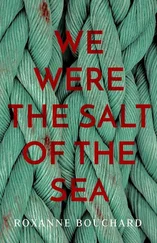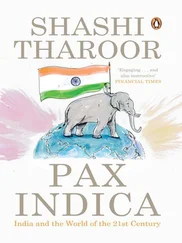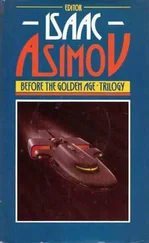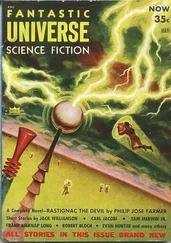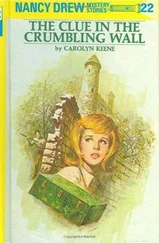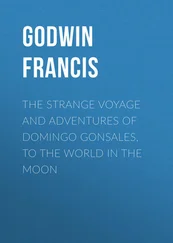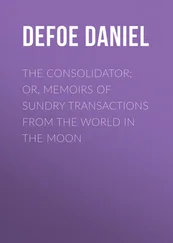Due to its historical significance, the Gravensteen in Ghent was chosen as the location for the memorial. Belgian artist Freddy de Vos from Drongen took on the task of designing it.
He placed an aluminium sculpture on a cascading base, in the middle of which the silhouette of a person has been cut out. He left the sculpture empty on the inside. To celebrate the official opening on 3 rdMay 1996, local school children placed letters inside which were addressed to political prisoners. The project, “Schrijfzevrijdag” (directly translated: “write them free”), was brought to life by Amnesty International Belgium. The artist himself left a small bronze sculpture as well as three small chunks of the Berlin Wall which had been given to him by a German colleague for the project. Two further small chunks were integrated and are visible from the outside. Alongside this are small stones from South Africa, where human rights activist and later President Nelson Mandela was imprisoned by the Apartheidregime.
GHENT
BELGIUM
Location:In front of the main building at Flanders Expo, Maaltekouter 1
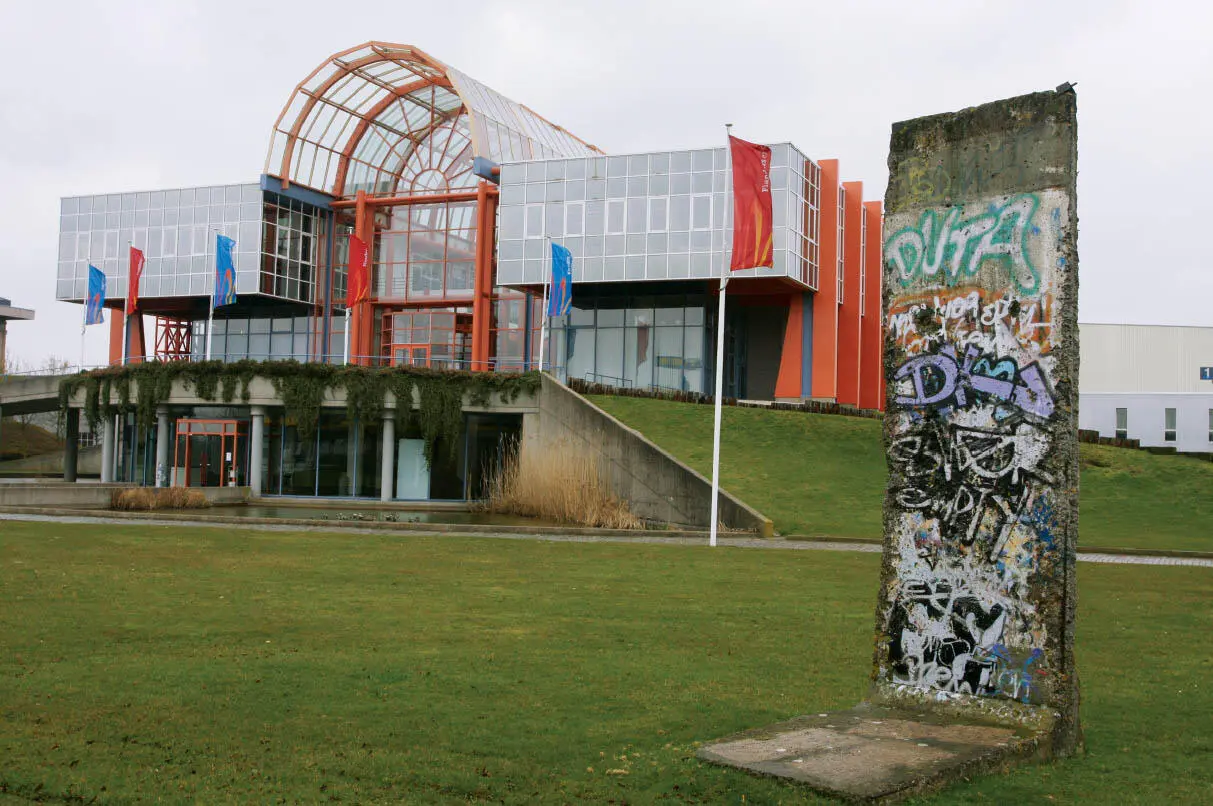
The Wall at Flanders Expo, Ghent
© Lode Anseel
A segment of the Berlin Wall has been on display in front of the main building at the “Flanders Expo” multi-purpose indoor arena since 1998. Lode Anseel, former chief accountant for the company and Berlin enthusiast, had the 2.6 tonne section of Wall brought to Belgium. He purchased it alongside a second piece in the mid-1990s in Berlin, where he remembered it had once separated Potsdamer Platz into East and West. Anseel succeeded in convincing the former Flanders Expo management to buy one piece and install it as an attraction on the company grounds. During a small public celebration, the segment was finally installed to the sounds of “The Wall” by British rock band Pink Floyd. The piece, branded on both sides with bright graffiti, is passed by tens of thousands of visitors on their way to the building every year.
ZWEVEZELE WINGENE
BELGIUM
Location:Ricksteenweg 6
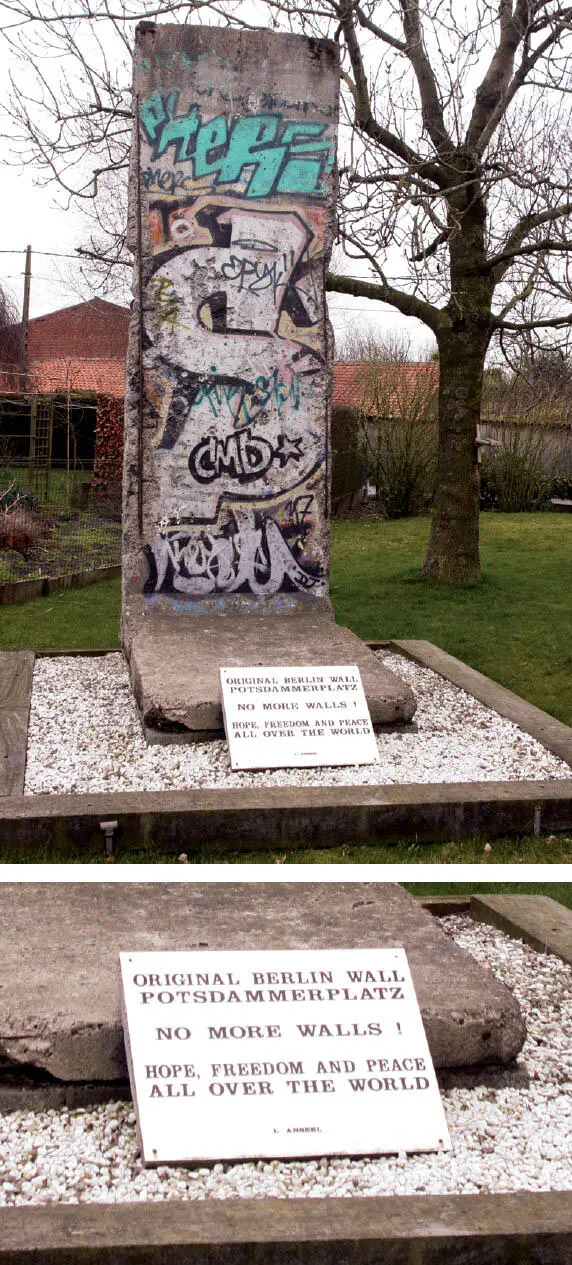
The Wall in Lode Anseel’s garden, Zwevedele Wingene
© Lode Anseel
The Berlin Wall has become a passion for Belgian photographer, Lode Anseel. The fate of the divided city and its world famous concrete Wall have not left him since his first school visit in 1977. Anseel wanted to get back to Berlin immediately on 9 thNovember 1989 when he saw reports about the Fall of the Wall all over the press. However, it was not until 1990 that he actually made the journey. He was in Berlin when the famous border control point “Checkpoint Charlie” was closed on 22 ndJune 1990. Anseel took countless photographs as well as a few small chunks of the Wall. He sold the chunks of Wall to a street-seller for four GDR Marks. In 1995, he opened his first larger photo exhibition about Berlin in Belgian Menen. Four years later, his pictures were presented to the public in Wingene – ten years after the Fall of the Wall.
By then, Anseel’s passion for the Berlin Wall had grown even more. He began to collect everything he could find that had anything to do with the former border and the GDR. He was particularly taken with the East German Trabant car. Anseel bought four Trabants in the nineties, amongst them a version which was used by the National People’s Army. He also owns a first generation Trabant P 50, which he managed to have signed by Soviet Head of State, Michail Gorbachev, Socialist Unity Party of Germany (SED) politician, Günter Schabowski, and GDR figure skater, Katrina Witt. He is particularly proud of one Trabant, which he has covered with banknotes and coins from 75 countries.
It was this passion for Trabants that led him be in possession of two Wall segments. He came across an article in Supertrabi (a magazine for Trabant enthusiasts) by a Berlin-based Trabant fan, who then put him in touch with someone selling parts of the Wall. Anseel also convinced his then employer, the Flanders Expo in Ghent, to buy a piece and organise the transportation. One piece remained at Flanders Expo and Anseel put the second in his garden. It still stands there today, complete with a small white plaque with the words: “ORIGINAL BERLIN WALL / POTSDA[M] MERPLATZ / NO MORE WALLS!, / FREEDOM AND PEACE / ALL OVER THE WORLD”
SOFIA
BULGARIA
Location:Boulevard Bulgaria, next to the National Palace of Culture
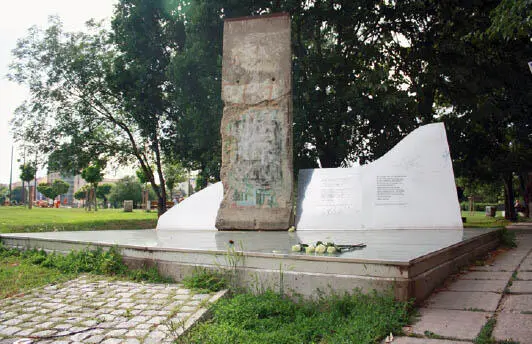
The Wall in Sofia
© Fanny Heidenreich
In spring 2006, the Berlin Senate gave a segment of the Berlin Wall to Sofia, the Bulgarian capital, as a “token gift of appreciation”. The initiative behind this gesture came from the Bulgarian foundation “Nasledstwo” (heritage). The foundation is dedicated to the preservation of Bulgaria’s heritage. The Balkan State branch of “Funke Mediengruppe” sponsors the project. The city government requested a piece of the Wall in March 2006. On 13 thApril 2006, after receiving consent from Germany, the decision was made by the city council to place the section of Wall in the park next to the National Palace of Culture. This location was chosen due to its position directly in the vicinity of the monument for the victims of the communist regime in Bulgaria, erected in 1999.
The city council assigned the construction of the Wall memorial to the “Nasledstwo” foundation. A design by architect, Bojko Kadinow was used, and the concrete segment was erected on an area laid with black flagstones. A tilted wave-like-wall stands behind it. Two texts, in German and Bulgarian, complete the memorial.
Ha 13. aBryCT 1961 г. eдHa CTeHa, paздeли БepлиH ГepMaHия, a c TяX EBpoпa и CBeTa Ha дBe чacTи. Бългapия бeшe зaTBOpeHa OT изTOчHaTa CTpaHa Ha CTeHaTa – дO 9. HOeMBpи 1989 г., KOгaTO Hapoдът я paзpyши .
Toзи OTлOMък OT БapлиHCкaTa CTeHa e дep OT rpaждaHиTe Ha БepлиH Ha rpaждaHиTe Ha Coфия, кaTO зHaK зa BъзCTaHOBeHOTO eдиHCTBO Ha EBpoпa и дOKaзaтeлCTBO, чe бългapитe ca Beчe CBOбOдHи xopa. БepлиH Maй 2006г .
[On 13 thAugust 1961 a Wall cut Berlin, Germany and with it Europe and the world in two. Bulgaria remained enclosed on the eastern side – until the Wall was torn down by the people on 9 thNovember 1989. This fragment of the Berlin Wall is a present from the people of Berlin to the people of Sofia – as a symbol of reunified Europe and as proof that the Bulgarian people are now free. Berlin, May 2006]
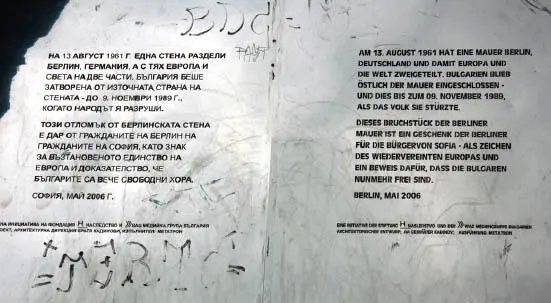
Information board in Sofia
© Fanny Heidenreich
Work to prepare the site had to be carried out quickly so that the official unveiling of the memorial could coincide with an upcoming visit from Berlin Mayor, Klaus Wowereit, on 16 thMay 2006. Workers from the company “Nidel” worked tirelessly to get the memorial site ready whilst the segment was transported from Berlin to Sofia by transportation company “Militzer und Münch”. Wowereit’s visit was eventually rescheduled and the handing over of the Wall to Sofia’s mayor, Bojko Borissow, actually took place on 20 thJune 2006.
Читать дальше





